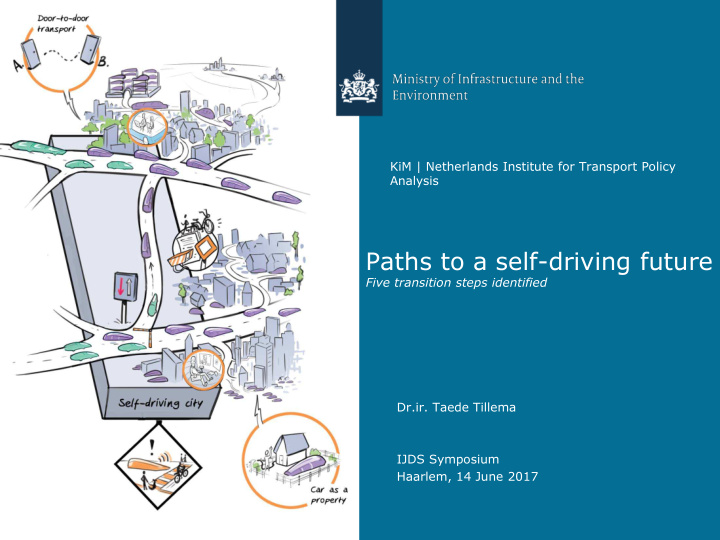



KiM | Netherlands Institute for Transport Policy Analysis Paths to a self-driving future Five transition steps identified Dr.ir. Taede Tillema IJDS Symposium Haarlem, 14 June 2017
Research programme 1.Driver at the wheel? – Four scenarios for a future traffic and transport system with automated vehicles 2.Paths to a self-driving future – Transition paths towards the scenarios – Perspective on policy options KiM | Netherlands Institute for Transport Policy Analysis
Definition: SAE-levels of automation Level Name Example Human driver monitors the driving environment 0 No automation Lane Departure Warning 1 Driver assistance Adaptive Cruise Control 2 Partial automation Parking Assistance Automated driving system monitors the driving environment 3 Conditional automation Highway Chauffeur 4 High automation Parking Garage Pilot 5 Full automation Robot Taxi KiM | Netherlands Institute for Transport Policy Analysis
Driver at the wheel? Uncertainties and scenarios sharing “Multimodal & shared “Mobility as a service: high automation” any time, any place” level 3,4 level 5 automation “Fully automated private “Letting go on highways” low luxury” KiM | Netherlands Institute for Transport Policy Analysis
Transition paths: the story line KiM | Netherlands Institute for Transport Policy Analysis
Two paths towards the scenario worlds KiM | Netherlands Institute for Transport Policy Analysis
Evolving cars, transition steps and a time line KiM | Netherlands Institute for Transport Policy Analysis
Evolution of the private car KiM | Netherlands Institute for Transport Policy Analysis
Sharing in bloom KiM | Netherlands Institute for Transport Policy Analysis
Man and machine (l 1/2) • Best of two worlds? – human beings excel in complex unexpected circumstances – technology supports driver – higher traffic safety – improved traffic flow • Or not? – driver looses attention: accidents – trust in technology undermined KiM | Netherlands Institute for Transport Policy Analysis
Cooperative driving (l 1/2) • Holy grail? – Efficient road use – Higher traffic safety – Less congestion – Less CO 2 • Or bridge too far? – Sensor and software reliability – Cyber security: hacks, privacy KiM | Netherlands Institute for Transport Policy Analysis
Mixed traffic (l 3/4) • Solves itself? – consumers appreciate safer traffic and efficient road use – investments in transition zones between highway and city • Or showstopper? – consumer prefers to be in control – dangerous interaction KiM | Netherlands Institute for Transport Policy Analysis
Urban dilemma (l 3/4) • Separate modes? – l5 technology far away – Adjust city infrastructure – l 3/4 lanes • Or driver in control? – l5 technology nearby – Separate modes too costly KiM | Netherlands Institute for Transport Policy Analysis
Self driving city (l 5) • Contested space? – bikers and pedestrians take the road – car traffic comes to a standstill • Or flexible interaction? – physical separation – technology – ‘pushy’ automated vehicle – culture KiM | Netherlands Institute for Transport Policy Analysis
Main conclusions • On the long run automated vehicles yield many positive effects for society • Highways and cities filled with fully automated vehicles are still rather far away – Yet, first steps are already being taken • Transition is crucial and determines how the future will look like – Implications for society differ considerably in the two transition paths • Transition consists of five major steps: – man and machine, cooperative driving, mixed traffic, urban dilemma, self- driving city • Transition in each step may progress smoothly or bumpy • In each step adaptive policy is key KiM | Netherlands Institute for Transport Policy Analysis
Thank you for your attention! english.kimnet.nl KiM | Netherlands Institute for Transport Policy Analysis
Recommend
More recommend